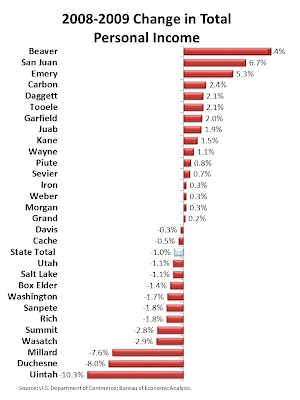

(Click images to enlarge.)
The U.S. Bureau of Economic Analysis has just released new total personal income and per capita income figures for Utah's counties. Yes, the "new" numbers are for 2009 (and you thought our data was dated). But, give the Bureau a break, lots information, time and effort goes into these estimates.
If you don't remember the official definitions of personal and per capita income, here's a refresher:
Personal income is the income received by all persons from all sources (it's a "total" for the area). Personal income is the sum of net earnings by place of residence, rental income of persons, personal dividend income, personal interest income, and personal current transfer receipts (such as government payments--Social Security, etc.).
Per capita personal income is total personal income of the residents of a given area divided by the resident population of the area. In computing per capita personal income, BEA uses the Census Bureau’s annual midyear population estimates.
What do the numbers say? Well, the most obvious observation is (drum roll, please)--on average Summit County residents receive far more income than the rest of us. Counties with a high proportion of population at either end of the spectrum (very young or very old) tend to have lower per capita incomes. Why? Most children don't earn anything at all and younger workers tend to earn less than older workers. And, while older, retired residents do receive income (pensions, government transfer payments, rents, interest, etc.), that income is typically less than that received by a working adult. Yes, the state of Utah has a low per capita income compared to other states. But, we are the youngest state in the nation with a very high proportion of population under the age of 18.
The effects of recession are also apparent on the growth (or lack thereof) in total personal income. Just less than half of Utah's counties experienced a decline in personal income between 2008 and 2009. The state itself saw personal income decrease by 1 percent. Personal income in most of the urban counties declined. On the other hand, many rural counties showed increasing total personal income. Of course, in some cases (such as Beaver County), the gains were related to construction projects rather than a long term improvements.
For more information about the new personal income data, click here.